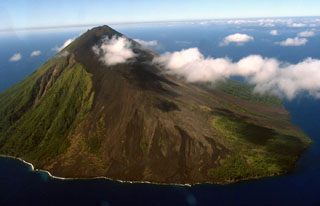Report on Lopevi (Vanuatu) — December 2005
Bulletin of the Global Volcanism Network, vol. 30, no. 12 (December 2005)
Managing Editor: Richard Wunderman.
Lopevi (Vanuatu) Minor discharges on 24-25 January 2006
Please cite this report as:
Global Volcanism Program, 2005. Report on Lopevi (Vanuatu) (Wunderman, R., ed.). Bulletin of the Global Volcanism Network, 30:12. Smithsonian Institution. https://doi.org/10.5479/si.GVP.BGVN200512-257050
Lopevi
Vanuatu
16.507°S, 168.346°E; summit elev. 1413 m
All times are local (unless otherwise noted)
As noted by the Wellington Volcanic Ash Advisory Center (24 and 25 January 2006), pilots reported a vertical plume rising from Lopevi at 0845 hours on 24 January 2006 to an altitude of 2.1-2.4 km and drifting to the S. At 0845 the next day, 25 January, the plume extended SE and was reportedly at 2.7 km.
MODIS satellite data also detected thermal anomalies around this time (0055 and 1020 hours on 24 January), preceded by an absence of measured anomalies for ~ 9 days (since 2240 hours on 15 January). Satellite thermal anomalies are often detected over this volcano.
Geological Summary. The small 7-km-wide conical island of Lopevi, known locally as Vanei Vollohulu, is one of Vanuatu's most active volcanoes. A small summit crater containing a cinder cone is breached to the NW and tops an older cone that is rimmed by the remnant of a larger crater. The basaltic-to-andesitic volcano has been active during historical time at both summit and flank vents, primarily along a NW-SE-trending fissure that cuts across the island, producing moderate explosive eruptions and lava flows that reached the coast. Historical eruptions at the 1413-m-high volcano date back to the mid-19th century. The island was evacuated following major eruptions in 1939 and 1960. The latter eruption, from a NW-flank fissure vent, produced a pyroclastic flow that swept to the sea and a lava flow that formed a new peninsula on the western coast.
Information Contacts: Rob Wright, Luke Flynn, and Eric Pilger, Hawai'i Institute of Geophysics and Planetology, University of Hawaii and Manoa, 168 East-West Road, Post 602, Honolulu, HI 96822 (URL: http://modis.higp.hawaii.edu/); Wellington Volcanic Ash Advisory Center (VAAC), MetService, PO Box 722, Wellington, New Zealand (URL: http://www.metservice.co.nz/).

